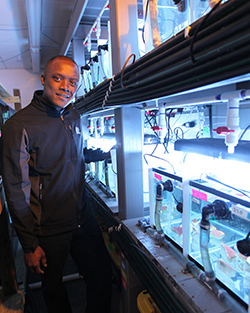
"The primary driver here is that I can see that students are more engaged in the lessons and that they are actually having fun and learning as they share and communicate with their colleagues."
Course: The Marine Environment
Department: Marine Sciences
Reflection:
I think that my redesign was actually successful!
I think the most significant change is that I am actually having fun teaching the lessons. The primary driver here is that I can see that students are more engaged in the lessons and that they are actually having fun and learning as they share and communicate with their colleagues. These changes certainly require that I am more prepared as an instructor because student input often changes the direction of the lessons. Also I often find that I have to be more willing share my experiences that are relevant to the lessons.
Course Description
This course introduces students to the nature of the oceans with specific emphasis on the physical, chemical, geological, and biological processes that occur in the world's oceans and how they interact in the different regions of the ocean environment. The course content begins with a discussion of the ocean planet and the history of ocean studies. Next, it navigates through plate tectonics, seawater properties, and ocean circulation. Finally, it concludes with an overview of marine ecology and ocean ecosystems.
This is a class for non majors and the size is typically 110. This is a fun course to teach but there are a number of challenges. First, it is rather difficult to get the students to work in groups because the specific classroom is not the best for group activities. Nevertheless, I have made it a point to get the students to interact with each other as much as possible. Also, some students find it particularly challenging and intimidating to share their ideas because they do not want to look bad to their peers. Sometimes activities in smaller groups help but I know that some students fall behind because they refuse to ask questions in a class of this size. I think the greatest challenge is the physical oceanographic section of the course. Students find the material very challenging. I have tried different approaches but every single year students struggle with the topics in this section of the course.
This class attract students at all undergraduates levels. There are some positive stories where students decide to work in a marine science lab on campus because they are excited by what they learned in the course. Evaluations thus far are relatively good but I think there is room for improvement. I have taught this class for three years prior to this semester.
Projected Design Elements
- Poll Everywhere
- Engaging Group Activities
- Reduce Content to Focus on Big Picture
I would definitely like to use Poll Everywhere or clickers to see how the students are grasping the material. The class is on Sakai and there is lot of communication with the students.
I have used some group activities but I would like to make these more beneficial to the students...make them more engaging and activity filled.
I would definitely like to step back a moment and consider which topics would be most beneficial to the students that sign up for the class. There is definitely a need to cut back and focus more on the big picture.
Incorporated Design Elements
- Group Activities
- Poll Everywhere
- Think-Pair-Share
- 21st Century Classroom
- Weekly News Article Summaries
- Students Required to Communicate with Each Other Outside of Class
Program: Finish Line Project




